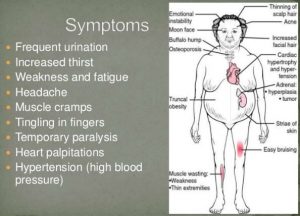Conn’s Syndrome : Definition, Etiopathogenesis, Symptoms, Clinical Features, Treatment And MCQs for NEET, GPAT, CSIR NET JRF
” It is an uncommon syndrome occurring due to the overproduction of aldosterone, the potent salt retaining hormone.”
1.] This syndrome is also called Primary hyperaldosteronism.
2.] This syndrome is more common in females than males.
3.] This syndrome is more common in people having age between 30s and 40s.
ETIOPATHOGENESIS :-
The condition primarily results due to adrenocortical disease as follows :
- Adrenocortical adenoma, producing aldosterone.
- Bilateral adrenal hyperplasia, especially in children (congenital hyperaldosteronism).
- Rarely, adrenal carcinoma.
- Primary hyperaldosteronism : In primary hyperaldosteronism from any of the above causes is associated with low plasma renin levels.
- Secondary hyperaldosteronism : On contrary to primary hyperaldosteronism, in secondary hyperaldosteronism occur in response to high plasma renin level due to the overproduction of renin by the kidneys such as renal ischemia reninoma or oedema.
SYMPTOMS :-
Following are the symptoms of Conn’s syndrome :
- Muscle strength decreases.
- Discharge of water or gases (voiding).
- Sometimes headache also happen.
- Increased thirst.
- Eyesight become weak.
- Patient suffering from Conn’s syndrome may also have paralytic attack that may come and go.
- Jerking and cramping in the muscles.

The above image is taken for education purpose only, from printerest.com
CLINICAL FEATURES :-
The principal features of conn’s syndrome are as follows :
- Hypertension, usually mild to moderate diastolic hypertension.
- Hypokalemia and associated muscular weakness, peripheral neuropathy and cardiac arrhythmia.
- Retention of sodium and water.
- Polyuria and polydipsia due to reduced concentrating power of the renal tubules.
TREATMENT :-
- In case if tumor arises in primary hyperaldosteroinism it can be removes laproscopically .
- In bilateral hyperplasia patient suffer from voiding i.e; discharge of water or fluids or gases from the body which will lead to dehydration so in order to maintain the water buildup in the body diuretics are used.
MULTIPLE CHOICE QUESTIONS :-
1.] In Conn’s syndrome, all the following are seen except ?
a. Hypokalemia
b. Hypernatremia
c. Hypertension
d. Edema
2.] Primary hyperaldosteronism is characterized by ?
a. Peripheral oedema
b. Metabolic acidosis
c. Decrease in Na content of sweat
d. None of the above
3.] Conn’s syndrome also known as ?
a. Hypoaldosteronism
b. Hyperaldosteronism
c. Hypertension
d. None of the above
4.] Life saving hormone is secreted by ?
a. Adrenal
b. Thymus
c. Thyroid
d. Pancreas
5.] Conn’s syndrome is caused due to ?
a. Hypersecretion
b. Hyposecretion
c. Both of the above
d. None of the above
6.] Corticosteroids are secreted by ?
a. Adrenal gland
b. Pineal gland
c. Pituitary gland
d. Thyroid gland
7.] Blood pressure is controlled by ?
a. Thyroid gland
b. Thymus gland
c. Adrenal gland
d. Parathyroid gland
8.] Which gland is concerned with salt equilibrium in body ?
a. Anterior pituitary
b. Pancreas
c. Adrenal
d. Thyroid
9.] Epinephrine and non – epinephrine together known as ?
a. Steroids
b. protein
c. Catecholamine
d. None
10.] Non – epinephrine leads to increase in ?
a. Blood pressure
b. Urine production
c. Cellular respiration
d. Release of epinephrine
SOLUTIONS :-
1.] (b) Hypernatremia
2.] (c) Decrease in Na content of sweat
3.] (b) Hyperaldosteronism
4.] (a) Adrenal
5.] (a) Hypersecretion
6.] (a) Adrenal gland
7.] (c) Adrenal gland
8.] (c) Adrenal
9.] (c) Catecholamine
10.] (a) Blood pressure
List of Successful GPATINDIAN CANDIDATES
REFERENCES :-
1.] Textbook Of Pathology By Harsh Mohan; 7th edition; Page no. 788.
2.] Robbin’s Basic Pathology; 5th edition; Page no. 1153 – 1154.